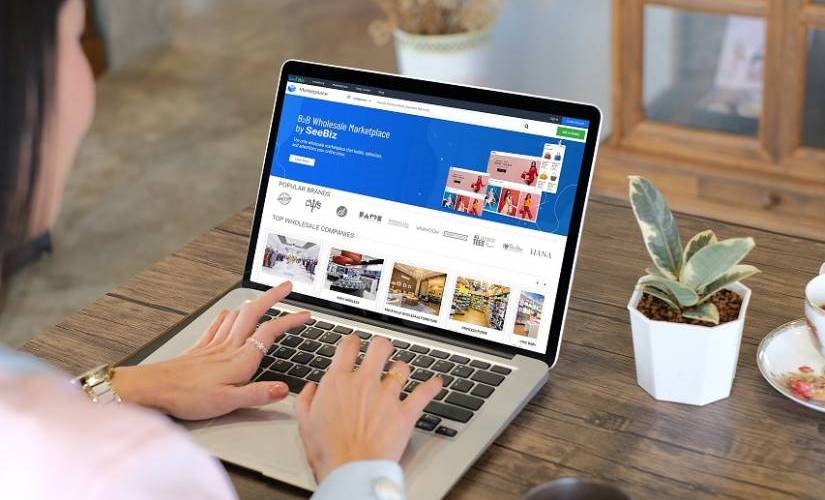Guide To Develop A Highly Successful Online B2B Marketplace

Many B2B companies are now looking to develop their own online B2B Marketplace with the potential of becoming industry leaders. The internet and technology have taken over businesses and marketing strategies, so it’s logical that any b2b company would want to capitalize on this medium to stay competitive in the market.
It’s not an easy decision, but several factors need to be considered before deciding whether or not to build your own online B2B Marketplace or use an existing online marketplace — such as Alibaba, Alibaba,comGlobal, eBay, and SeeBiz — or sell your products or services on Shopify or Amazon.
The B2B wholesale market has seen significant growth over the last few years, with a huge opportunity to be tapped into. This guide will introduce you to the basics of developing an online B2B marketplace.
Then takes you through the various considerations for developing a highly successful online B2B marketplace.
Choosing the Right Niche
The first step to developing a successful online B2B marketplace is to choose the right niche. You’ll want to select a niche with enough potential customers to make the marketplace viable — but not so much competition that it will be challenging to get started. To help you narrow down your options, consider these factors:
-
The Needs of Your Target Market:
What do they need or want that they can’t find elsewhere?
-
The Size Of Your Target Market:
Is it large enough to support a marketplace?
-
The Level of Competition:
How many other businesses are already serving this market?
-
Your Personal Interests and Expertise:
What are you passionate about?
These are all critical questions to ask yourself when deciding on a niche.
Once you’ve chosen one, keep in mind that there may be some specific regulations for serving your particular industry; for example, any company selling prescription drugs must comply with FDA regulations if they’re selling over-the-counter medications. If this is the case for your chosen industry, then there’s no point in continuing unless you’re willing to take on those requirements from day one!
Getting Started
The first step is finding a niche or market you can tap into. Then, once you have found a call, you need to create a platform or website that will serve as the foundation for your marketplace. Finally, after your marketplace is up and running, you need to populate it with buyers and sellers.
You can reach out to businesses in your target market and offer them incentives to join your marketplace. Then, once you have a critical mass of buyers and sellers, you need to start promoting your marketplace to drive traffic and generate sales.
Social media advertising and traditional marketing are two ways to promote your marketplace. You should also be sure to offer customer service and technical support, so customers remain happy and continue using your marketplace. Finally, analyze the data from each transaction on your marketplace to understand what’s working well and what needs improvement.
Setting Up Your Website
Before you can launch your marketplace, you’ll need to build a website. You can either hire a web development company or use a platform like WordPress to create your site. If you go the DIY route, make sure to choose a responsive theme so that your site looks good on all devices.
Once your website is up and running, you’ll need to add content and design it in a way that is user-friendly and visually appealing. Remember, first impressions are everything about online businesses, so ensure your site looks professional and trustworthy.
Next, you’ll need to set up your marketplace. If you want to add and sell your own products, you can either build or buy a platform from a third-party vendor. Most of your work is done if you’re simply providing online wholesale shopping sites (seebiz dotcom online wholesale shopping sites) for other businesses. However, if you plan on operating as a service provider by listing client business offerings and taking a cut of each sale, then you’ll need to build it yourself or hire someone to help with development.
Consider SEO
If you want to ensure that your online marketplace is booming, you must ensure that it is visible to your target audience. One of the best ways to do this is to invest in SEO. Optimizing your site for search engines can attract more visitors and improve your chances of conversion.
Here are a few tips to get you started
-
Create Content:
Writing original articles will help you rank higher on Google.
-
Research Keywords:
Find out what people are searching for before deciding on your keywords.
-
Use Tags:
Tags will help you connect with related topics or other sites.
-
Write Titles and Descriptions:
Make them interesting so that they will be found by people who don’t know about your site yet.
-
Monitor Analytics:
Be aware of how many people visit your site, what they click on, etc., to improve where necessary.
Always ensure your content is relevant and valuable to your audience. It’s also a good idea to write articles with solid titles and descriptions, as search engines will pick them up.
Start Building your Contacts
Creating a thriving online marketplace takes more than a great website. You need the right mix of suppliers, manufacturers, distributors, and customers to make it work. That’s why it’s essential to start building your contacts as soon as possible.
Here are some tips for finding the best people in your industry:
1- Join trade associations related to your niche
2- Attend trade shows that allow attendees to register for free or at a low cost
3- Approach vendors at stores that sell similar products
-
Join Trade Associations Related to Your Niche
These groups will often list local members on their sites or blog. You can also find them by searching for the keyword trade associations on Google. The Chamber of Commerce is an excellent place to start your search and read reviews about specific associations on its website.
Remember, if you don’t see any trade associations related to your niche, that’s okay too! If this is the case, you can still reach out to businesses in your industry and build relationships with them.
-
Attend Trade Shows
These events often offer deals for buying booths, so this is an opportunity for vendors who want to grow their business with minimal cost. It’s also a great way to promote your products and services. Trade shows are also where buyers can see new products and meet sellers in person, making it easier for them to choose the right supplier.
To maximize the success of trade shows, you should focus on having a booth that stands out from the others by displaying the product or service in the best possible light or offering giveaways such as stickers, pens, or other branded items which can be used as promotional items.
-
Approach Vendors at Stores That Sell Similar Products
It’s always easier when someone comes up to you and asks if they can help you find something rather than making cold calls from home! The same is true for a marketplace business, so identify where your target market shops for products.
Talk to vendors about their product lines, discuss their business, and ask them if they would be interested in being a vendor in your marketplace. If not, offer to pay them for the privilege of having them speak with potential vendors that contact you.
How to Sell Products Online
If you’re selling products online, there are a few things you’ll need to do to be successful. First, you’ll need to choose a platform to sell on. There are many options, so spend time researching which will work best for you and your products.
The first step is choosing the right platform for your business. Sellers should consider their level of expertise, the products they offer, and how much inventory they want to keep before deciding on an e-commerce platform.
After this decision, sellers should develop a list of all their products with detailed information about each item, including specifications or features like size or color. Then, setting up an account with the desired e-commerce software will allow sellers to publish items for sale; sellers should also add all necessary financial information such as credit card types accepted and PayPal email addresses.
Once you’ve chosen a platform, you’ll need to create listings for your products. Include high-quality photos and descriptions that accurately represent what you’re selling. You’ll also need to set up a payment system so customers can purchase your products.
Finally, promote your online store through social media and other marketing channels. Following these steps, you can set up a successful online store to help you reach your sales goals.
Different Types of Accounts Available With Payment Gateways
When developing an online marketplace, one of the first things you need to do is choose a payment gateway. There are many different payment gateways available, and each has its own features and benefits.
Here are some of the most popular payment gateways credit card processors, internet merchant accounts, bank merchant accounts, check merchant accounts, cash merchant accounts, and offline credit card readers.
In choosing a payment gateway for your business’s needs:
- First, it’s essential to understand what sales transactions your site will process.
- Read reviews from other users about the performance of various providers.
- Verify that their providers offer tools for integrating into your e-commerce website.
- Compare prices on processing fees.
- Consider any other charges incurred as part of using their service.
Understanding The Business Model of a B2B Marketplace
A business model describes how your company makes money and is essential to developing an effective business plan. But the question remains: what makes one business model different from another?
This article examines the business model of B2B marketplaces, explaining the challenges that marketplaces face, as well as the strategies they use to succeed. To build a thriving online B2B marketplace, you must understand how others have done it before you.
Introductory Information
A B2B marketplace is an online platform. That enables businesses to search for, discover, and buy products and services from other businesses. The key to success for a B2b marketplace is creating a network of buyers and sellers. They transact with each other regularly. Therefore, the platform must offer value to both sides by connecting them and providing a smooth and efficient transaction process.
How They Work
Business-to-business marketplaces work by connecting businesses that need products or services with businesses that provide them. These marketplaces typically take a commission on each transaction that they facilitate. In order to make money, they need to have a large number of buyers and sellers using their platform. To encourage this, they often offer lower prices than their competitors.
User Experience
A B2B marketplace is a platform that connects businesses with other businesses, usually in order to buy or sell products or services. To understand how such a marketplace works, it’s essential first to understand the different types of business models.
The most common business model for a B2B marketplace is the subscription-based model. This is where businesses are charged a monthly or annual fee to access the marketplace.
Monetization Strategies
The first step is to identify how you will make money. The most common monetization strategy for B2B marketplaces is charging a commission on transactions. Other options include charging subscription fees, listing fees, and advertising.
In some cases, charging an up-front fee may be more advantageous. For example, offer professional services or consulting rather than product sales. In addition, up-front pricing may be more appropriate because it discourages buyers from returning again and again.
Why is it Important to Get your Business Model Right?
A well-designed business model will help you answer critical questions about your business, such as your target customers, what value you’re offering them, and how you plan to make money. Without a strong business model, getting caught up in the day-to-day details of running your business and losing sight of your long-term goals is easy.
Business Model Example – Let’s Take SeeBiz as an Example
SeeBiz is a B2B marketplace that connects businesses with service providers. Businesses can browse through the SeeBiz website and find service providers that fit their needs. The businesses can then contact the service providers through the SeeBiz website to request services.
The service providers can then provide services to the businesses through the SeeBiz website. The businesses can then pay for the services through the SeeBiz website.
Final Words on Tips For Developing an Online Marketplace
The best way to create a successful online marketplace is to start with a niche market. This will help you focus on a specific group of buyers and sellers and give you a better chance to build a strong community.
You’ll also need to ensure your platform is easy to use and provides the features that buyers and sellers need. Creating a successful online marketplace takes time and effort. It will take time before you start generating revenue and profits. Never rush these things. Finally, don’t forget to promote your marketplace. The more people who know about it, the more successful it will be.
Featured Image Credit: Provided by the Author; Thank you!
The post Guide To Develop A Highly Successful Online B2B Marketplace appeared first on ReadWrite.
(41)







